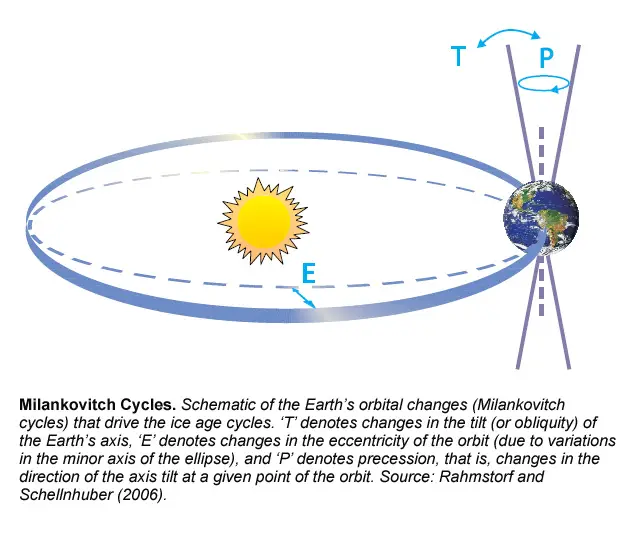The Milankovitch cycles, or ‘orbital’ theory of the ice ages is now well developed. Ice ages are generally triggered by minima in high-latitude Northern Hemisphere summer insolation, enabling winter snowfall to persist through the year and therefore accumulate to build Northern Hemisphere glacial ice sheets. Similarly, times with especially intense high-latitude Northern Hemisphere summer insolation, determined by orbital changes, are thought to trigger rapid deglaciations, associated climate change and sea level rise.
These orbital forcings determine the pacing of climatic changes, while the large responses appear to be determined by strong feedback processes that amplify the orbital forcing. Over multi-millennial time scales, orbital forcing also exerts a major influence on key climate systems such as the Earth’s major monsoons, global ocean circulation and the greenhouse gas content of the atmosphere.
Available evidence indicates that the current warming will not be mitigated by a natural cooling trend towards glacial conditions. Understanding of the Earth’s response to orbital forcing indicates that the Earth would not naturally enter another ice age for at least 30,000 years.

It is well known from astronomical calculations that periodic changes in characteristics of the Earth’s orbit around the Sun control the seasonal and latitudinal distribution of incoming solar radiation at the top of the atmosphere (hereafter called ‘insolation’).
Past and future changes in insolation can be calculated over several millions of years with a high degree of confidence. Precession refers to changes in the time of the year when the Earth is closest to the Sun, with quasi-periodicities of about 19,000 and 23,000 years. As a result, changes in the position and duration of the seasons on the orbit strongly modulate the latitudinal and seasonal distribution of insolation. Seasonal changes in insolation are much larger than annual mean changes and can reach 60 W m–2.
The obliquity (tilt) of the Earth’s axis varies between about 22° and 24.5° with two neighbouring quasi-periodicities of around 41,000 years. Changes in obliquity modulate seasonal contrasts as well as annual mean insolation changes with opposite effects at low vs. high latitudes (and therefore no effect on global average insolation).
The eccentricity of the Earth’s orbit around the Sun has longer quasiperiodicities at 400,000 years and around 100,000 years. Changes in eccentricity alone have limited impacts on insolation, due to the resulting very small changes in the distance between the Sun and the Earth. However, changes in eccentricity interact with seasonal effects induced by obliquity and precession of the equinoxes. During periods of low eccentricity, such as about 400,000 years ago and during the next 100,000 years, seasonal insolation changes induced by precession are not as large as during periods of larger eccentricity (see diagram above).
This material is sourced from the: Working Group I to the 4th Assessment Report of the Intergovernmental Panel on Climate Change, Technical Summary.
